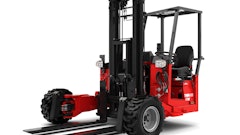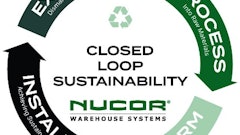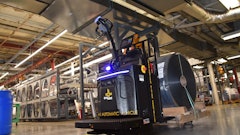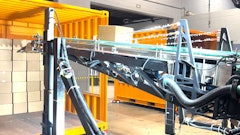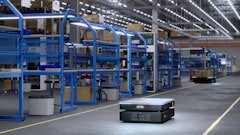
Look in all the right places to save energy, achieve fast payback.
Many decision-makers are unaware of all the places they can reduce energy losses and save money—while also achieving a fast payback. Here are nine ways to gain ground on sustainability goals that aren’t always top of mind.
1. Address trailer door hinge gaps: Semi-trailers with swing-out doors create 1.5-inch to 2-inch gaps on either side of the trailer when they’re parked at the loading dock and opened for loading and unloading. The gaps are equivalent to a 2.5-square-foot hole that allows air and expensive energy to freely flow in and out.
The solution is to close the gaps with a dock seal or shelter that seals the trailer-door hinge gaps. Yet the enclosure also needs to provide full, unobstructed access to trailer loads. Both objectives can be achieved by installing a soft-sided shelter that incorporates hooks on the shelter’s side curtains to seal trailer door hinge gaps and prevent airflow in and out of a facility—while also providing full trailer access.
Depending on climate, users can gain $400 to $1,000 worth of additional savings per year per dock position, above and beyond what an ordinary shelter can provide. Typical ROI: One to three years.
2. Close the “fourth” side of the dock opening: Dock seals and shelters are used to seal three sides of the loading dock opening, including both sides and on top. Yet heating and cooling energy readily escapes through gaps where the dock leveler, trailer and dock seal or shelter all meet at the bottom of the door opening. In other words, most facilities don’t typically consider sealing the “fourth” side of the door opening. In addition to unwanted airflow, heat transfer through the steel leveler deck adds to substantial energy loss.
Install a pit-sealing under-leveler seal to seal this area on virtually any type of leveler. The simple device uses a compressible vinyl sealing curtain and other components to close off the pit area beneath the leveler as well as open air gaps in leveler corners.
A separate header curtain constantly maintains the seal when the leveler is in an above-dock position.
Savings vary based on climate, but most can save $200 to $900 annually per dock position. Typical ROI: six to 18 months.
3. Don’t put up with dock leveler and door gaps: Energy is readily lost in places like the gaps between the dock leveler, dock pit wall and sectional door bottom; gaps in the perimeter of the sectional overhead door; spaces found on the sides of dock levelers between the leveler itself and the dock pit wall; and gaps at the back of the leveler. Although they might seem harmless, the gaps represent major conduits for lost energy. The space around the sides of a dock leveler alone can equate to a hole as large as 14 inches by 14 inches in diameter.
An array of energy-efficient dock leveler and door weather seals can solve the problem with relative ease and low cost.
Depending on the climate and the number of gaps shut down, annual energy savings per dock opening can range from $2,000 to $4,000. Typical ROI: As little as three months.
4. Tighten the seal at the pit floor: The energy losses related to gaps around a loading dock opening quickly add up. A single solution that addresses them all is a vertical-storing dock leveler, which allows the overhead dock doors to close down tightly to the pit floor when a semi-trailer isn’t present. Doing so provides more control over interior humidity and temperature at the dock.
Some systems also include a “Drive-Thru Application,” which allows the truck to back up to the loading dock with its doors closed. The truck driver does not need to get out of the cab. The operator inside the facility opens the overhead door and then opens the trailer doors inside of the building. The leveler is then lowered into position in the trailer.
The result is an extra measure of climate control that helps maintain an uninterrupted cold chain, aside from efficiency and security benefits.
Because each installation is unique, it’s difficult to estimate annual energy savings and payback. However, there’s little question that thousands of dollars in annual savings can be achieved along with a quick ROI.
5. Upgrade to advanced exterior dock door technology: Not all industrial doors are alike. Additionally, a door’s cycle times (opening and closing) and the seal it provides are more important than R-value when it comes to energy efficiency.
Installing high-speed doors offers great potential to deliver energy savings. The doors allow people and/or equipment to move quickly through openings. Some technically advanced high-speed, roll-up doors are rated to operate up to 100 inches per second—leaving very little time for energy to escape. Well-designed high-speed doors also incorporate a sufficiently weighted soft-bottom edge to provide a tight bottom seal.
Depending on the climate, savings of $400 to $7,000 per door opening per year are achievable. Typical ROI: One to three years.
6. Move interior air the right way: High-speed ceiling fans are ineffective at pushing trapped warm air down from the ceiling. The stratified air also doesn’t get mixed with the air that is close to the floor, leaving a greater temperature disparity from floor to ceiling.
Consider installing high-volume/low-speed (HV/LS) ceiling fans as a solution. In addition to moving more air than traditional fans, HV/LS fans use little energy to gently move warm air near the ceiling back down toward the floor and into more areas where it’s needed. Newer, advanced-designed HV/LS fans also cycle air better for a mixing effect that creates a much more uniform air temperature from floor to ceiling for energy savings during the colder months.
During the warmer months, the fans’ light breeze moving across employees’ skin has a cooling effect. That means the thermostat can be raised without reducing the level of employee comfort.
A single HV/LS fan can reduce annual heating and cooling costs by as much as 20-30 percent, depending on the climate. Typical ROI: As little as six months.
7. Close the door on energy losses: Poor perimeter seals on sectional doors are clear pathways for energy losses. The problem occurs when side and bottom seals wear over time, creating gaps between the door and the building wall. Gaps can also develop between sections of the door and at the top of the unit. Even insulated sectional doors with high R-Value and other thermal properties lose their effectiveness if the perimeters are not sealed properly.
Check all sectional doors to ensure they’re properly sealed. If gaps exist, consider replacing your side and/or bottom seals. There is a variety of brush, vinyl and foam seals available. If the door panels are warped or damaged, consider replacing them with flexible, impactable panels to help prevent future maintenance issues.
If a new door is required, evaluate all the aspects of your application. Insulation, impactability, sealing, and ventilation/vision are just a few aspects to consider.
The savings with new seals, door panels, or new sectional doors varies based on the extent of the gaps that exist and the application. At the very least, a properly sealed door can save users hundreds of dollars per year in avoided energy losses and payback is often measured in months.
8. Get control of cooler and freezer openings: Doors with frost and ice issues drive up energy costs. The high costs are the result of slow moving doors, or the use of heat lamps and air curtains to keep the door panel free of frost.
Technically advanced high-speed cold storage doors eliminate the need for traditional approaches to tackle frost issues. As an example, the latest model upward-acting, high performance door uses a full perimeter seal with an insulated curtain to create an insulated barrier between the freezer temperature and the door tracks to minimize frost build-up.
Savings of up to $10,000 annually per position. Typical ROI: 15 months.
9. Plan the work and work the plan: Gaining control of any energy costs is a matter of planning and execution.
As part of the process, have a trained equipment representative conduct a facility-wide energy audit to get an accurate picture of the savings to be gained. Include utility rebates in the plan since they accelerate payback. From there, it’s a matter of working the plan to accomplish sustainability goals in places where significant energy savings are well within reach.
Swietlik is customer relations manager, Rite-Hite Corp., Milwaukee.












